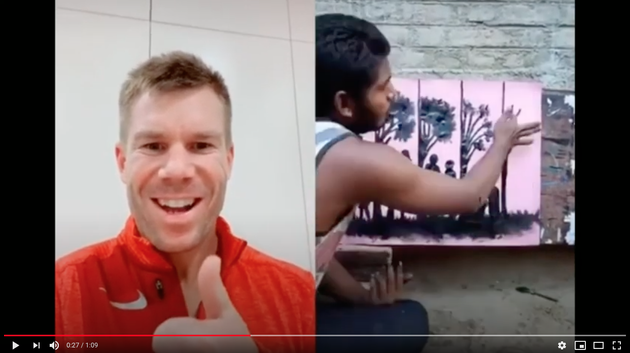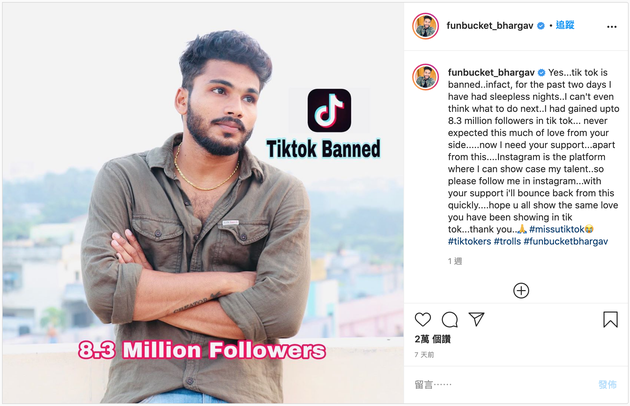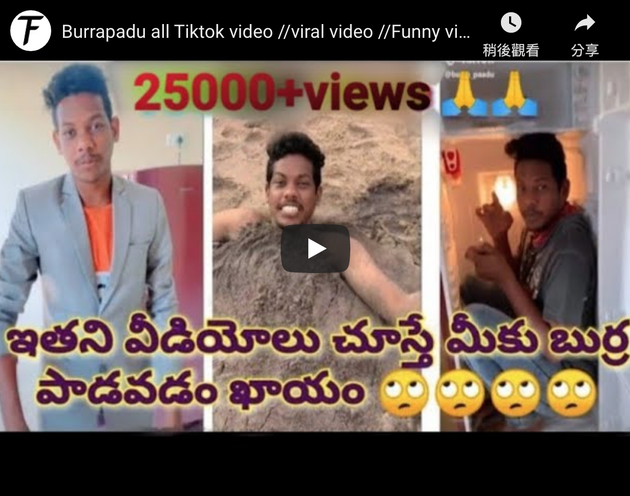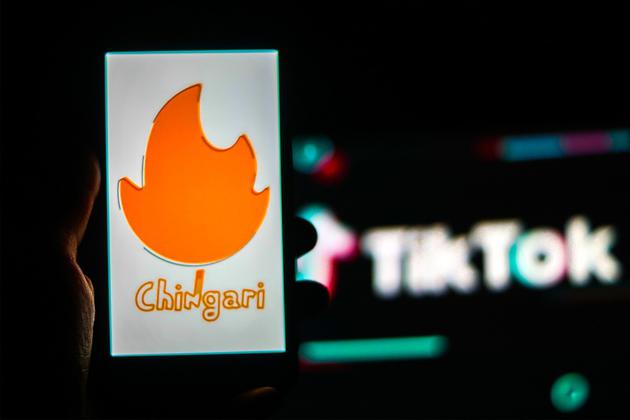On the evening of June 29, 23 year old Prem Vats was busy uploading a funny Bollywood video on TikTok, totally unaware of what had just happened outside: the Indian government announced that it would ban the use of a series of applications in the country, and TikTok was on the list.
After a while, a friend who saw the news called Watts with glee to tell him that TikTok was banned and that Watts' good luck was over.
"I was stunned and couldn't believe it," Watts said.
In less than 24 hours, 59 applications, including TikTok, were inaccessible.
Watts had expected his fan base to exceed 10 million this month. Now, the number of fans is still at 9.5 million. His income also came to an abrupt end.
The reality was so unexpected that it gave Vaz and more than 12 million Indian creators like him a blow.
Disable 59 apps?
On Monday (June 29), the Indian government, citing "data security and protection of the privacy of 1.3 billion Indians", announced that 59 Chinese applications were banned in the country, including TikTok, Helo and WeChat, the head social media platforms, as well as mainstream applications in many other fields, such as ShareIT, UC browser and shopping app Club Factory.
TikTok has more than 200 million monthly active users in India. India is also the largest market for this application outside China. TikTok's development in India coincides with the popularization of affordable mobile Internet services in India. This helped TikTok quickly gain a foothold in the second and third tier cities of India and harvest a large number of rural users.
Torsha Sarkar, a policy officer of the Indian Internet and Social Research Center, said: "Applications like TikTok make India's digital participation more democratic and break the stereotype that social media only belong to the English speaking and well-educated elite groups in society. This ban will mainly affect the absence of mainstream culture and economy." The creator of the background. "
Watts, who was ridiculed by his friends for his good fortune, has a deep understanding of this.
Watts graduated from the local community college. After graduating in 2017, he first came into contact with Musical.ly (merged with TikTok in 2018). At that time, he not only had no confidence in himself, but also lost some money. In 2018, he won the Creator Award on TikTok, which immediately boosted his confidence and started his online celebrity career.
When the market is good, Watts can earn $2000 to $2700 a month; At the worst, you can earn 600-700 dollars a month. On average, the average income of a head online celebrity (with tens of millions of fans) is about $4000 to $5300.
Now, everything is gone.
Fame and wealth destroy each other
Divyanka Sirohi, who lives in Ghaziabad, a suburb of Delhi, is only 22 years old this year. But with her income share on TikTok, she has been able to buy a house for her family. Before the app was banned, Cirosi had 4.9 million fans on TikTok. But now she is full of worries about the future. She lost her income share on TikTok. Where does the money for mortgage repayment come from? "I used to focus all my energy on TikTok, and I really don't know what to do next," she said. "Although I have an Instagram account, that account is basically unpopular."
TikTok is also an important income for many Indian users during the epidemic.
Mahesh Kapse, 23, lives in a small village near Videlba in Maharashtra. In February, he downloaded TikTok out of curiosity. Gradually, he began to release small videos of his paintings on TikTok, and also painted portraits for people. By June, in just three months, he had accumulated 1.25 million fans and could earn 60000 rupees from videos released. During the epidemic, when his rural parents did not work, his income became the only source of income for the family.
 Cappucci draws for fans
Cappucci draws for fans "I never thought that I could make so much money by publishing videos. People in the village also started to look at me with new eyes, which was great," he said.
However, when he opened TikTok at the end of June and saw the news that the application was banned, he was so worried that he could not sleep all night. "I feel abandoned by God!" Cappucci said. "Nothing, nothing."
For many people, TikTok has also enhanced their self-confidence and is a good helper for ordinary people to experience the fun of being a "red man". Manoj Sharma, a clinical psychologist in Bangalore, pointed out: "We are more active in the online world than in real life. All of us want to be better ourselves. TikTok just gives people the opportunity to become idols. Then imagine that this opportunity suddenly disappears, which must be a big blow."
Shivani Kapila, the creator of TikTok, is the popular online girl who makes TikTok videos in the eyes of neighbors. When she learned that she could not access the app, Kabila cried sadly. She said that it was as if the efforts of the past two years "suddenly disappeared". "TikTok gave me a new life and made me who I am now. But now, where can I find so many fans and how can I make money..." she sobbed.
Sashi Kumar, who wants to enter Bollywood, said that TikTok is a way for him to realize his film dream. "It (TikTok) not only brings me income, but also gives me a chance to become famous. But now, money and fame are gone."
How many people start from scratch
TikTok Red Bagov (net name: Funbucket Bhargav) comes from a small village in Vijjanakron, Andra Pradesh. Bagov became famous in TikTok. The symbolic "Oh, my God! My God!" made him famous at home and abroad.
Bagov's entrepreneurial path is very inspiring. Bagov, with a low level of education, took the borrowed smartphone to send videos on TikTok. After several years of efforts, he now has his own office, manages a team of about ten people, and even adds a new car to himself.
TikTok is Bagov's main position. He said, "I can't sleep through the night these days. I still have ten employees waiting for me to pay my wages. Now I don't know what to do next... I worked hard to achieve today's achievements. Suddenly, everything seems to be back to the starting point, and I can only start from scratch."
 Bagov tried to re-establish a fan group on Instagram, and he wrote: "I hope you can like my video as you do on TikTok."
Bagov tried to re-establish a fan group on Instagram, and he wrote: "I hope you can like my video as you do on TikTok." Going to other platforms to start from scratch is probably a true portrayal of Indian Internet celebrities these days. They released videos with Instagram account and YouTube link on TikTok and invited fans to follow them on other platforms. Local applications such as Chingari and Roposo also hope to seize market share by taking advantage of TikTok's frustration in India and actively throw olive branches to online celebrities.
For cross platform online celebrities and enterprises, this barrier is acceptable.
HoneySingh, CEO and co-founder of ARM Worldwide, a digital marketing company, said that most brands would choose to use YouTube again to gain new users in the region.
Gopa Kumar, chief operating officer of Isobar India, believes that besides YouTube and Instagram, many Indian local applications can also replace TikTok, but it takes time to reach the popularity and number of fans on TikTok.
Nita, the creator of TikTok content in Mumbai, said that in addition to TikTok, she has also been running a fan group on Instagram. During the epidemic blockade, she made a little money through Instagram. "After TikTok was banned, my followers on Instagram rose by more than 50000 overnight. So, I think I can make it."
Although experts believe that mature content creators will gradually move closer to YouTube and Instagram to make up for the loss of brand content revenue, most creators are not so lucky. TikTok is their main source of income, and the realization incentive given by TikTok is incomparable to other platforms.
Watts said that after TikTok was banned, he also tried to move to Instagram and YouTube to cooperate with some brands on the new platform. But the income is much lower, less than half of that on TikTok. In addition, Watts added that posting videos on Instagram and YouTube is more troublesome. Accustomed to the huge amount of music materials and various filters on TikTok, he felt powerless to post videos on Instagram and YouTube.
Bagov said that many platforms have come to him recently, and even invited him to serve as their brand ambassador. But he is not sure whether he can accumulate so many fans on the new platform. He said that all his resources were on TikTok, and the sudden ban of TikTok put him in trouble. Although he also wants to move to other platforms, he is worried that fans will not follow him to the new platform. "... Please follow me on Instagram..." He repeatedly stressed in his posts on the new platform.
Sash Kumar, who wants to be a star, has moved TikTok video to YouTube, but it is hard to say whether he can achieve the success as before.
 Video released by Sash Kumar
Video released by Sash Kumar Cappers and other online celebrity creators don't know which social media platform to choose next. They have tried YouTube and local applications Mitron and Chingari. But like Watts, they are not very satisfied with the new platform. Some people continue to release videos on a new platform and start again with difficulty; Some people are still immersed in the grief of losing millions of fans, unable to relax; There are also those who are optimistic and try to adapt to changes, like Cappucci.
"The platform will change, but my talent will not be lost. I want to be famous, and I will try my best to realize my dream," Kapser said.
The first station of localization
Not long after the announcement of the ban by the Indian government, or even before it officially came into effect, the number of downloads per hour of Chingari, an Indian short video application, has reached 300000 to 400000, an astonishing growth. The number of daily active users of another local short video application, Roposo, also tripled within days.
TikTok was banned, leaving 200 million Indian users nowhere to go. The market then began to seething. Players from all walks of life jumped into this localized game and tried to build a viable Indian social network from scratch.
Social media is no better than others. Although the ban of the Indian government is applied in many fields, only a few fields have real "Indian local alternatives". For example, e-commerce applications such as Shein and Club Factory are also banned, but there are also Flipkart and Myntra. These can become local alternatives to banned e-commerce applications, and they already have a mature user base.
The vacuum belt of 200 million Indian users has made social media the first stop of the strategy of "localization of India".
 Chingari
Chingari It is said that the short video application Chingari aims to acquire 100 million users within three months; Mitron, a local short video application mentioned earlier, also said that it aims to acquire 100 million users within three months. What is the concept of 100 million users? It took TikTok a year to break through 100 million users.
In fact, three months does not mean that local applications are too radical, but that they have too little time left for themselves. TikTok may return at any time, and this uncertainty has exacerbated the sense of haste within the Indian application ecosystem. In the field of social media, it is almost impossible to subvert the platform that has taken root. TikTok didn't subvert Facebook Or Instagram, which just creates a new market for itself with short videos.
However, TikTok's temporary departure has given hope to other local applications. "This is a once-in-a-lifetime opportunity for start-ups," said Arun Tadanki, head of LetsVenture, a financing platform in Bangalore. "At this pace, Mitron's applications may produce 100 million or 200 million users in three to six months. At that time, even if the banned applications can return to the market, the situation will be very different."
This is a race against time.
Shanzhai TikTok is not enough
Prasanto K. Roy, a technical and policy consultant, stressed that it is not enough to simply replicate the TikTok experience. "The source code of similar popular applications is everywhere on the Internet, and the cheap ones are only $25. But these are not enough," Roy said. "The market vacuum left by TikTok is a good opportunity, but only a few players can seize this opportunity."
TikTok's short videos are different in form and audience. At the same time, most of these social media applications in India are regarded as "replicas" of existing platforms.
Sumit Ghosh, the co-founder of Chingari, said frankly that he intended to copy TikTok's strategy. He said that copying a platform is not always wrong. Facebook also copied Snap Chat's Stories function is better. But the key is, Ghosh said that the Indian platform needs to have its own characteristics. When it comes to feature functions, Mitron and Roposo both try to create the "content classification" function, which is somewhat similar to the channel on TV.
But many creators believe that these local platforms will not last long. First, the technology is not mature enough; Second, there is a lack of funds, not only to recruit talents, but also to subsidize creators.
 "Counterfeit TikTok" Mitron is alleged to have vulnerabilities, revealing user information
"Counterfeit TikTok" Mitron is alleged to have vulnerabilities, revealing user information Although many second and third tier city creators who lost the TikTok platform did want to try these new platforms, they were disappointed.
"I also tried to use Chingari, but the application always went wrong, so I had to give up," Watts said.
Another online celebrity on TikTok, Ajay Barman, said that he downloaded Chingari, Mitron and Roposo, and then deleted them all. Because the use experience of these applications is too poor, and more importantly, video transmission is not as fast as that on TikTok. The so-called "content classification" function of local characteristics also made him feel very weak.
In addition, while the download volume of these Indian local platforms soared, many leading online celebrities and brands chose to re attack on Instagram. Perhaps the biggest beneficiary of the ban on Chinese applications is not the Indian platform, but the American social media platform.
"People have probably forgotten that Facebook is still the elder brother in the social media field. Although Facebook is always controversial, it is still a mature platform for content sharing. I wouldn't be surprised if Facebook would launch more flexible functions to facilitate users to publish video content in a few days," said Shudiep Majumdar, co-founder of marketing company Zefmo Say.
Now, in India, all social media applications want to be the TikTok substitute in the hearts of 200 million users. But even if everyone is looking for the next perfect replacement, they still hope that TikTok will return as soon as possible.
"The ban will affect many people because TikTok has such a large user base," Nita said























